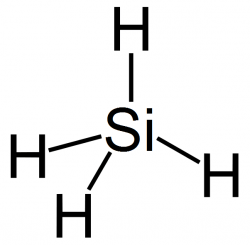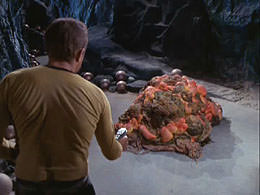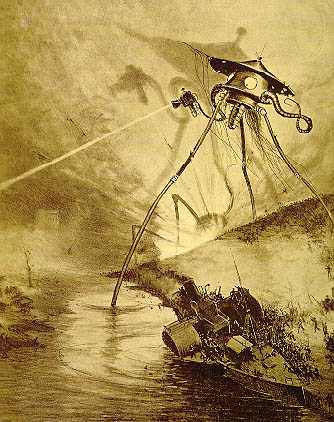[/caption]
Editor’s note: Bruce Dorminey, science journalist and author of “Distant Wanderers: The Search for Planets Beyond the Solar System,” interviews NASA astrochemist Max Bernstein for Universe Today about the possibility of Silicon-based life.
Conventional wisdom has long had it that carbon-based life, so common here on earth, must surely be abundant elsewhere; both in our galaxy and the universe as a whole.
This line of reasoning is founded on two major assumptions; the first being that complex carbon chain molecules, the building blocks of life as we know it, have been detected throughout the interstellar medium. Carbon’s abundance appears to stretch across much of cosmic time, since its production is thought to have peaked some 7 billion years ago, when the universe was roughly half its current age.
The other major assumption is that life needs an elixir, a solvent on which it can advance its unique complex chemistry. Water and carbon go hand in hand in making this happen.
While the world as we know it runs on carbon, science fiction’s long flirtation with silicon-based life — “It’s life, but not as we know it” — has become a familiar catchphrase. But life of any sort should evolve, eat, excrete, reproduce, and respond to stimulus.
And although non-carbon based life is a very long shot, we thought we’d broach the issue with one of the country’s top astrochemists — Max Bernstein, the Research Lead of the Science Mission Directorate at NASA headquarters in Washington,D.C.
Bruce Dorminey — IS IT WRONG TO ASSUME THAT LIFE COULD BE BASED ON SOMETHING OTHER THAN CARBON?

Max Bernstein — It’s important for us to keep an open mind about alien life, lest we come across it and miss it. On the other hand, carbon is much better than any other element in forming the main structures of living things. Carbon can form many stable complex structures of great diversity. When carbon forms molecules containing cxygen and nitrogen, the carbon bonds to nitrogen and oxygen are stable. But not so much so that they can’t be fairly easily undone, unlike silicon-oxygen bonds, for example.
Dorminey — DOES THE RECENT NASA-FUNDED RESEARCH AT MONO LAKE, CALIFORNIA WHICH TOUTED THE DISCOVERY OF BACTERIA WITH DNA THAT USES ARSENIC INSTEAD OF PHOSPHORUS RATTLE THE CURRENT PARADIGM?
Bernstein — That was a really cool result, but the basic structure was still carbon. The arsenic was said to have replaced phosphorus, not carbon. The discovery of this putative arsenic organism may prove to be incorrect, but it’s a hypothesis with science behind it, and not just someone tossing out an idea and leaving it at the level of what if you replaced carbon with silicon?

Dorminey — SILICON SEEMS TO BE THE MOST POPULAR NON-CARBON BASED CANDIDATE, ARE THERE OTHERS THAT ALSO MIGHT BE FEASIBLE?
Bernstein — It’s hard to imagine anything that would be more likely that silicon because there is nothing closer to carbon than silicon in terms of its chemistry. It’s in the right place on the periodic table, just below carbon. On the face of it, [silicon-based life] doesn’t seem too absurd since silicon, like carbon, forms four bonds. CH4 is methane and SiH4 is silane. They are analogous molecules so the basic idea is that perhaps silicon could form an entire parallel chemistry, and even life. But there are tons of problems with this idea. We don’t see a complex stable chemistry [solely] of silicon and hydrogen, as we see with carbon and hydrogen. We use hydrocarbon chains in our lipids (molecules that make up membranes), but the analogous silane chains would not be stable. Whereas carbon-oxygen bonds can be made and unmade — this goes on in our bodies all the time — this is not true for silicon. This would severely limit silicon’s life-like chemistry. Maybe you could have something silicon-based that’s sort of alive, but only in the sense that it passes on information.
Dorminey — IF SILICON-BASED LIFE IS OUT THERE, HOW COULD WE EVER DETECT IT REMOTELY?
Bernstein — We are seriously arguing about how we would remotely detect life just like us, so I really couldn’t say. Presumably technology-using organisms, whatever their biochemistry, will produce technology, so the Search for Extraterrestrial Intelligence (SETI) may be our best shot.
Dorminey— HOW WOULD YOU LOOK FOR SILICON-BASED LIFE HERE ON EARTH?
Bernstein — When seeking an alien organism its really tough because you just don’t know what molecules to look for. One would have to be satisfied by something a bit more ambiguous, like sets of molecules that should not be there. For example, if you were an alien Silicon organism, you might not be looking for our biochemistry, but the fact that you kept seeing exactly the same chain lengths over and over again might tip you off to the fact that those darn carbon chains might actually be the basis of an organism’s membranes.

Dorminey — WHERE ARE THE LARGEST CONCENTRATIONS OF SILICON HERE?
IN SAND?
Bernstein — In sand or rock. There are literally megatons of silicate minerals on Earth.
Dorminey — HAS ANYONE EVER CLAIMED DETECTION OF SELF-REPLICATING EXAMPLES OF SILICON HERE ON EARTH?
Bernstein — There have been ideas about minerals holding information just as DNA holds information. DNA holds information in a chain that is read from one end to the other. In contrast, a mineral could hold information in two dimensions [on its surface]. A crystal grows when new atoms arrive on the surface, building layer upon layer. So, if a crystal sheet cleaved off and then started to grow that would be like the birth of a new organism and would carry information from generation to generation. But is a replicating crystal alive? To date, I don’t think that there is actually any evidence that minerals pass information like this.
Dorminey — IS THE CRUX OF THE PROBLEM THAT SILICON-BASED LIFE WOULD BE SO SLOWLY REPLICATING THAT IT COULD NEVER MAKE IT IN A DYNAMIC UNIVERSE?
Bernstein — I don’t think that any Silicon life form could be a biological threat to us. If they were high tech, they might eat our buildings or shoot guns at us but I don’t see how they could infect us. We run hot and move fast. If we don’t, things will catch us and eat us.
If they are also tougher than we are and whatever feeds on them is also slow and Silicon based maybe being slow doesn’t matter.
Dorminey — WHAT WOULD BE THE SIGNATURES OF SILICON-BASED LIFE?
Bernstein — If they are not technological, they would be very tough to detect. We could look for unstable, unexpected silicon molecules; some high energy molecule that should not be there, or molecular chains of all the same length.
Dorminey — DO YOU THINK THAT SILICON-BASED LIFE MIGHT EXIST SOMEWHERE OUT THERE?
Bernstein — Maybe deep below the surface of a planet in some very hot hydrogen-rich, Oxygen-poor environment, you would have this complex silane chemistry. There, maybe silanes would form reversible silicon bonds with selenium or tellurium.
Dorminey — IF SUCH SILICON-BASED LIFE DID CROP UP, WHAT WOULD BE ITS EVOLUTIONARY ENDGAME?
Bernstein — If it could evolve past the protist [microorganism] stage, then I think it could evolve intelligence. I have no idea how likely it is for intelligence to evolve, but I can believe in silicon crystals passing information from layer to layer or in silicon artificial intelligence, but I don’t expect to see silicon apes playing their equivalent of “Angry Birds” on their Silicon-Phones.
Dorminey — IF SILICON-LIFE DID EVOLVE, WOULD ITS LIFESPAN BE MUCH LONGER THAN ITS CARBON-BASED ANALOGUES?
Bernstein — The replicating mineral that I described earlier would be living very, very slowly on Earth’s surface. But maybe somewhere very much hotter, its lifespan would be shorter. That’s because presumably lifespan is connected to the pace of your chemistry, which depends on temperature.
Dorminey — FINALLY, WHAT WOULD ENDANGER NON-CARBON-BASED LIFE?
Bernstein — Physical harm for sure. Presumably you could take a jackhammer to it?
But our biochemistry would not be pathogens to it; we could not “infect” them as was the case in “War of the Worlds.”


Life is life. Whatever we decide that it is life, is life. What kind of people think about intelligent minerals or lichens? 😀 And if I hear that catchphrase again I’m gonna kill someone. 😀
Yes, of course. Ignorance is the answer.
Well, I was in a bad mood and the article pissed me off for some reason. I don’t like the phrase “life as we don’t know it”. I don’t like the way this topic is popularized. I’m European and that might be the problem. Now that I read it again, I actually really like it. I’m not opposed to silicon based life, the article somehow mixed in my head and I got a different impression. “intelligent minerals or lichens” are no more in my head. 😀 I’m just gonna shut my mouth and watch from now on…
If you think about it, the people claiming that advanced civilizations would create self-replicating Von Neumann machines that would spread throughout the galaxy, are really claiming that carbon-based life would create (and maybe be supplanted by) silicon-based life. In the same way that RNA-life may have been necessary to get to DNA-based life, carbon-based life may be a necessary pre-condition for silicon based life. (We might think of those Von Neumann machines as robotic spacecraft, but those that can evolve would likely supplant those that cannot, and in a few billion years take on forms that we cannot predict.)
It is more likely that alien biochemistry which involves silicon also involves carbon. It might be a case of carbon chains which have links or sites with silicon, or maybe silicone which has oxygen. Pure silcon life seems implausible at this time.
LC
There’s an argument that the first life on Earth was self-replicating and silicon-based in the forms of very complex clays. They started to use organic molecules and we stole the planet from them. See Graham Cairns-Smith’s book “Genetic Takeover” – recommended.
Does life even have to be self replicating? Might consciousness not be the only requirement for life and could it arise spontaneously in some arrangement or combination of subatomic particles that exists without necessarily recreating or renewing itself? Whether a human brain or similar structure came to exist as a result of evolution or some other unknown process shouldn’t intuitively affect its intrinsic capability to become conscious.
But could we talk to it, that is the question?
Likely it has to be self-replicating and variable (evolve) or it wouldn’t last against those populations that evolve. That is why we see relatively few populations of “eternal” organisms today.
I think I have to rethink my definition of life as I’m probably discounting bacteria and plants with my consciousness definition.
But my main point remains, although carbon based molecules might be a requirement for life “as we know it” (sorry Head-A-U) to evolve, it might not be absolutely necessary for something else with which we could communicate, and which could respond intelligently to its environment.
As to whether robots or cyborgs would be considered alive, I think there would be a requirement for something considered to be “life” to have arisen spontaneously through natural physical processes, rather than created or manufactured.
I think I have to rethink my definition of life as I’m probably discounting bacteria and plants with my consciousness definition.
But my main point remains, although carbon based molecules might be a requirement for life “as we know it” (sorry Head-A-U) to evolve, it might not be absolutely necessary for something else with which we could communicate, and which could respond intelligently to its environment.
As to whether robots or cyborgs would be considered alive, I think there would be a requirement for something considered to be “life” to have arisen spontaneously through natural physical processes, rather than created or manufactured.
I think I have to rethink my definition of life as I’m probably discounting bacteria and plants with my consciousness definition.
But my main point remains, although carbon based molecules might be a requirement for life “as we know it” (sorry Head-A-U) to evolve, it might not be absolutely necessary for something else with which we could communicate, and which could respond intelligently to its environment.
As to whether robots or cyborgs would be considered alive, I think there would be a requirement for something considered to be “life” to have arisen spontaneously through natural physical processes, rather than created or manufactured.
Why in the world are all the element names capitalized? This isn’t correct according to normal English usage nor does it follow the standards of the International Union of Pure and Applied Chemistry. It makes the article incredibly annoying to read.
Is the interviewer seriously retarded? Or from fox news?
If he is from fox news, means that he is retarded. So either case, the result is the same.
You don’t have to yell, Bruce.
Stop with the yelling!
I have yet to hear a convincing argument for Si-based life. Silicon just isn’t as dynamic and versatile as Carbon.
We need to choose what our definition of life includes. Would robots be considered alive if they became intelligent? How about cyborgs? While life as we commonly think of it may not be able to be silicon-based, could an AI that we create be considered silicon based life? Also, it may be possible to create silicon bonded amino acids and proteins in a lab to create silicon based viruses as a proof of concept experiment. Would it work? Who knows, but it might be worth trying.